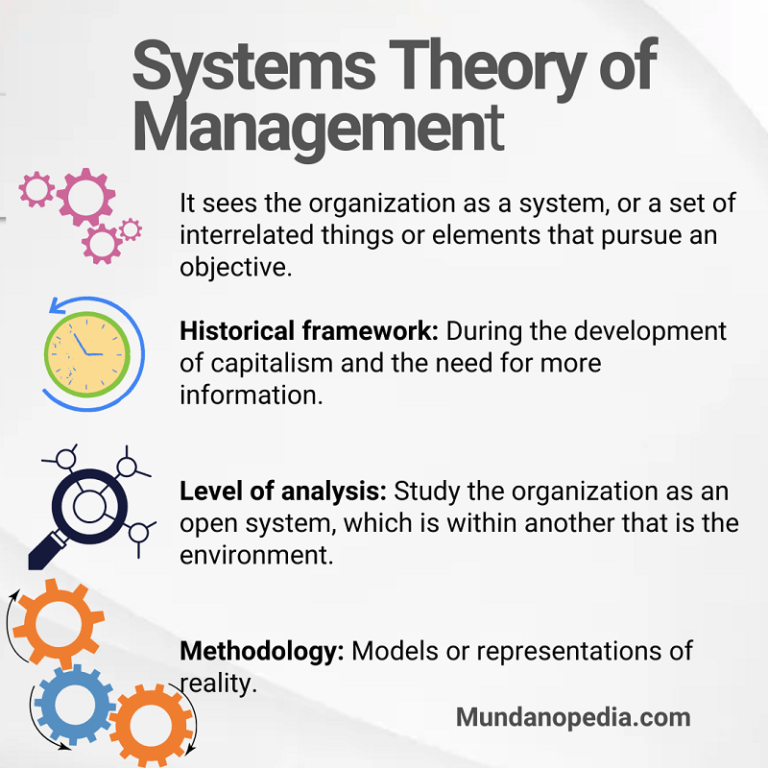Systems Theory of Management & Organizations
Systems theory of management
Systems of management is a conception of companies or organizations as a system, made up of interrelated parts that are also related to the external world. This theory allows the systematic explanation of organizations and the elements that influence their environment.
Contents

The organization as a system
The systems approach sees of the organization as a set of interrelated parts, or a set of subsystems that each fulfill specific functions to achieve the final objective. Organizational experts apply this approach to view the organization from a broader perspective to further understand its functioning.
Many disciplines attend the study and solution of organizational problems, not only psychologists, sociologists, and anthropologists as in the human behavior school of management, but also industrial engineers, administrators, statisticians, economists, etc. All schools converge today and their contributions are present, some are applied more than others but all have contributed to modern management theory.
Systems theory studies the different elements of the system, their interrelation, processes, and their objectives, and this differentiates it from others schools like the human behavior school. The latter focuses on the most important element, the individual, whose behavior influences others and is the basis of the success of any organization.
Related: Human Behavior School of Management
Types of systems
There are two types of systems, open and closed, the closed ones don’t interact with the environment and the open ones do because they receive inputs, process them and return them to the outside as finished products.
The organization as a closed system
The organization was seen as a close system mainly in the past, during the first studies about it, the main feature was that the external influence was ignored. The focus was on a technical-operative level, in achieving greater efficiency.
The Organization as an open system
Currently, modern theory sees the organization as an open system because it recognizes its intimate relationship with the environment, which is the society from which it receives energy, information or materials, which it processes and returns to the outside as products or services that satisfy needs, this cycle is repeated over and over again.
Characteristics of open systems
Open systems combat entropy, maintain stability, and receive feedback to fix bugs and improve performance.
Applications
This approach has served to show various points of view, including:
- The organization as a subsystem within society.
- As a set of functional subsystems (departments)
- It allows visualizing it with its fundamental elements (environment, objectives, structures, and processes).

Importance of the systems theory of management
The environment is an essential part of organizations, because the external environment has a direct and indirect influences over it due of its effects on what happens inside, it’s determining factor.
The organization has an immediate environment with which it’s directly related (customers, suppliers, advisers, regulatory entities, adversaries and public opinion) and a general environment (society) that includes the social, cultural, economic and political realities.
Management must know it very well in order to guarantee the adaptation and permanence of the organization over time and to be able to face the different levels of complexity and uncertainty that create a pleasant, disturbed or turbulent environment.
Systems theory (administrative thinking)
Systems theory appears at a time of greater technological advances and knowledge resulting from the experiences of previous thinking. It covers some omissions made by the classical and behavioral thinkers and differs from them in their values, level of analysis, and methodology.
Systems theory goes beyond the individuals and their behavior, since its level of analysis is based on the concept of systems, that is, a set of interrelated elements that seek to achieve an objective.
The individual is Among the various elements of the system and is considered the most important element, but what the school really focuses on is how all those elements interrelate.
The theory also recognizes that there is no single correct way to manage and organize because that depends on the environment.
Features
- Historical framework. It appeared during the development of capitalism, large companies and the need for more information.
- Level of analysis:It studies the organization as an open system, which is within another that is the environment with which it exchanges resources and information.
- Methodology:Its methodology is the use of models or representations of reality that makes it possible to use relevant variables to describe, explain, and forecast the behavior of systems under certain conditions.
- Value system: It’s based on two basic concepts:
- All organizations have common structural features, regardless of their sector.
- Their activities are regular, many repetitive, and therefore their behavior can be predicted.
Criticism and limitations of the systems theory
- The non-consideration of the “human factor” and its spontaneity and unpredictability.
- The differences between organizations and their dynamism are ignored.
- Impossibility of empirical verification of some systemic concepts.
- Non-quantifiable, complex extra-organizational factors.
Contributions
- Identification and characteristics of the components of the organization.
- Current valid theory, which makes it possible to study and understand organizational phenomena.
- It gives a greater understanding of the organization and therefore eases its planning, organization, direction, and control.
See also